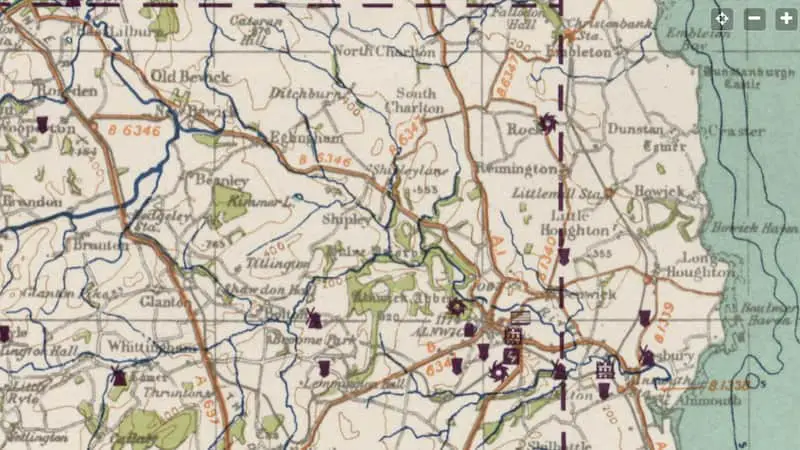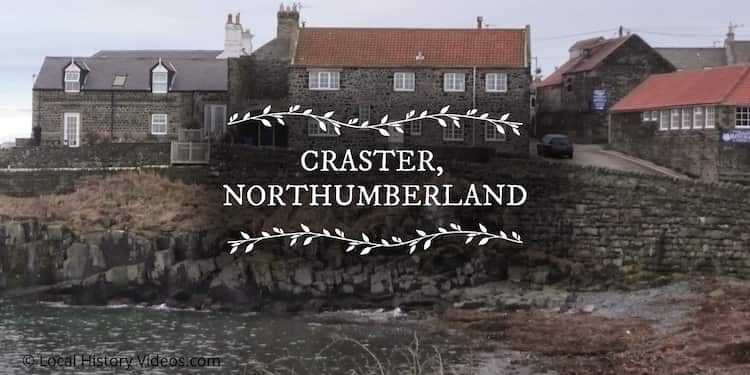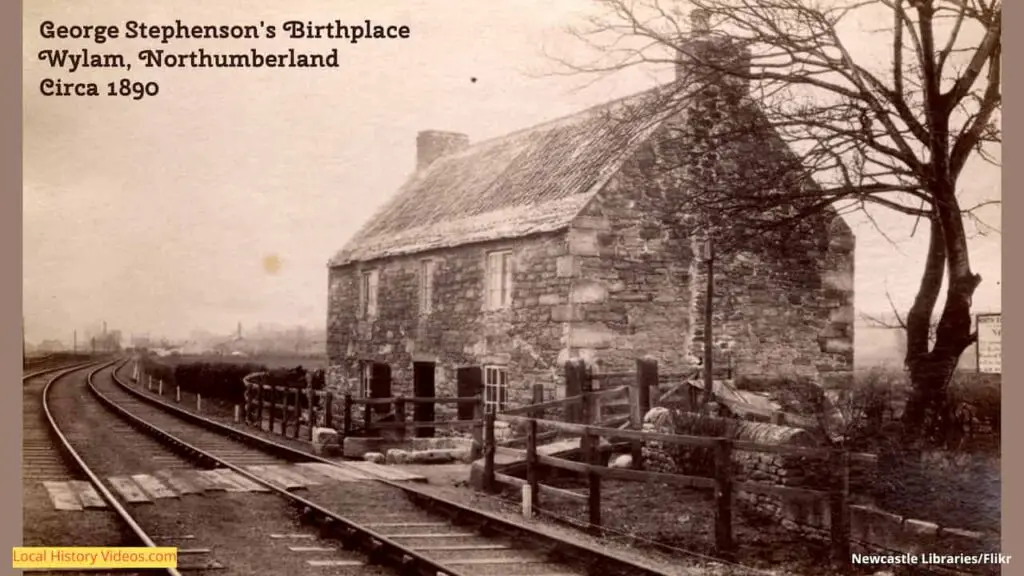Enjoy a glimpse of history through old images of Craster, Northumberland, England.
Given how few houses sit nestled against the sea in the Northumberland village of Craster, it’s surprising to discover old footage of the settlement and its activities. But then, it’s a place that has beauty, history and tradition much admired by its many visitors.
World War II Map
Craster appears on the Militärgeographische Einzelangaben über England : militärgeographische Objektkarten mit Objektbildern, a German map published for military planning during World War II which identified local sites of industry.
I’ve added an extract of the map here, but you can find the full map and key on the Library of Congress website.
The symbol at Rock identifies a sawmill. Nearby Alnwick had two sawmills, a mills, several water industry sites, and a steam electricity plant. Nothing has been noted at Craster beyond the existence of the village.

Craster Kippers 1982
It’s just a quick thirty second segment, but this footage takes us to the famous Craster Kippers production back in 1982.
A long standing Robson family business, the herrings are prepared using no chemicals or artificial colouring. Then they are smoked for around 14 hours.
Kipper production – Craster Kippers – 1982: ThamesTv on YouTube
A Bit of Craster History
Extract from
History, topography, and directory of Northumberland, comprising a general survey of the county, and a history of the town and County of Newcastle-upon-Tyne, with … sketches of the Boroughs of Gateshead and Berwick-upon-Tweed …
by Whellan, William and Co
Published in 1855
Page 575
CRASTER township is situated six miles north-west of Alnwick. It contains 796 acres, and its rateable value is £1,120. T. W. Craster, Esq., and Major Clutterback are the landowners.
The number of inhabitants in 1801 was 100; in 1811, 118; in 1821, 146; in 1831, 212; in 1841, 247; and in 1851, 222 souls.
This township has been held by the Craster family since the 13th century and is one of the few manors in the country that is yet held by the family to whom it was originally granted.
CRASTER TOWER is a neat edifice, surrounded by some fine old woods, through whose foliage a fine view of the sea may be obtained.
DIRECTORY. – T. W. Craster, Esq., Craster Tower; James Grey, farmer; William Wood, farmer; and Charles Archbold, innkeeper.
Victorian Craster Fishermen
Extract from
Report on the Crab and Lobster Fisheries of England and Wales
by Great Britain Commission on Crab and Lobster Fisheries, Francis Trevelyan Buckland, Sir Spencer Walpole, Archibald Young, J. Aloysius Blake, Joseph Hayes, Sir Thomas Francis Brady
Published in 1877
Page 33
JAMES ARCHIBALD ( examined by Mr. Walpole )
A fisherman at Craster.
Has been 41 years crab-catching. Craster is about 8 or 9 miles south of North Sunderland. The crab ground extends off Craster 4 miles south, 3 north, and 4 to 5 seawards.
There are not above 15 boats from Craster, but they have had 18 or 19. They have had many losses of life at sea, which have diminished the number of boats.
When he was a lad, there were about a dozen boats out of Craster. When he was a lad, crab and lobster fishing began before December and ended at the close of May.
The Craster men still keep to this old custom, but at Boulmer, Newton, and Beadnell, he believes that the creels have been shot already, i.e., in November. Thinks this is an injury to the fishery. Thinks the lobsters migrate from one ground to the other, and that the unseasonable fishing at one place affects the fishery in other places.
There is not one crab or lobster now for 20 when he was a lad. When he was a lad, he could, with his present tackle, have gotten 50 score crabs in a night. The most they ever got last year was 22 score in one day. Never caught 30 lobsters in a day in his life. 12 would have been the average catch 40 years ago.
There is many a day now when the boats won’t average three lobsters. Does not think the average for the season would be more than three.
The crabs were the first to fall off.
This failure began about 25 years ago.
The lobsters began to fall off about the same time. Thinks the decrease was due to excessive fishing. There was a great increase of fishermen about that time. The railways had been made a few years before. Thinks that there are not merely more fishermen to divide the take among, but that the crabs have decreased in number.
Thinks the proper remedy is a close season for crabs and lobsters. The close season should commence on the 1st of June and end on the 30th of November. This is the universal opinion at Craster. The coast guard could enforce the law.
Thinks also that the little crabs and lobsters should be put back. A 4-inch gauge might do. A 4-inch gauge in the barrel might also do for lobsters.
GEORGE DAWSON ( examined by Mr. Buckland )
A fisherman of Craster for 40 years.
Has heard Mr. Archibald’s evidence. Agrees with him that crabs and lobsters are falling off.
When he first went fishing, they had nothing but iron rings; they now use creels.
Agrees with a close season commencing on 1st June and ending on 30th November.
Thinks the Scotch crabs are larger than the Northumberland crabs. Thinks that all crabs under 4 inches should be returned to the sea. Will agree to a 4-inch barrel gauge for lobsters if all the rest will do so. Crabs are a capital bait for lobsters, but not for crabs. Has broken up crabs as bait for codling. It is a good bait. There are very few crabs, however, used as bait at Craster.
The haddocks are caught with mussels, which they get from Stockton.
In November, more than half the crabs are soft. The close season, if it were enacted, would save all the soft crabs. The he crabs continue softer longer than the she. The “shes” cast their shells in the height of summer. Cannot say how far crabs will travel. They crawl most in thick water.
The crab pots are baited with fish. The crabs are sent away alive. The lobsters have their claws tied, not plugged.
Has store places for keeping lobsters. They are called “hullies,” i.e., boxes with holes. The bottom of the sea is rocky, very little sand.
In January, they begin to fish in 22 to 23 fathoms of water and draw closer to shore for lobsters as the year advances.
WILLIAM MASON ( examined by Mr. Walpole )
Has lived in North Sunderland for 13 years. Was bred and born at Craster. Has been a fisherman for seven years for crabs and lobsters. Fished off Craster.
Thinks the crabs are increasing in number.
Believes that there is a bigger tonnage of crabs sent away than ever by North-Eastern Railway. The station-masters at Chat Hill and at Christon Bank so informed him. Thinks, also, lobsters are increasing. Thinks that the cod are an enemy to the crabs.
Does not think that any legislation is necessary, except that he is in favor of a close season. The fishing season should begin on the 1st of February and end at the last of May for lobsters, and the last of June for crabs. The question of size should be left to merchants and fishermen of the crabs, but all lobsters under 4 inches in the barrel should be thrown away. A 5-inch crab is a large crab.
More Pictures of Old Craster
Old Craster in Northumberland, England, enjoyed through historic photos, vintage pictures & archive film. Browse history in these fascinating old images of a bygone era on my Pinterest Board.
More about Northumberland
- Seaton Delaval, NorthumberlandEnjoy a glimpse of history about Seaton Delaval in Northumberland, North East England, UK.
- Wylam, NorthumberlandEnjoy a glimpse of history about Wylam in Northumberland, North East England, UK.
- Wooler, NorthumberlandEnjoy a glimpse of history about Wooler in Northumberland, North East England, UK.
- Woodhorn, NorthumberlandEnjoy a glimpse of history about Woodhorn in Northumberland, North East England, UK.
- Widdrington, NorthumberlandEnjoy a glimpse of history about Widdrington in Northumberland, North East England, UK.
- Whittonstall, NorthumberlandEnjoy a glimpse of history about Whittonstall and Newlands in Northumberland, North East England, UK.
- Whittingham, NorthumberlandEnjoy a glimpse of history about Whittingham in Northumberland, North East England, UK.
- Whitley, NorthumberlandEnjoy a glimpse of history about the ecclesiastical parish of Whitley in Northumberland, North East England, UK.
- Whitfield, NorthumberlandEnjoy a glimpse of history about Whitfield in Northumberland, North East England, UK.
- Whalton, NorthumberlandEnjoy a glimpse of history about Whalton in Northumberland, North East England, UK.


